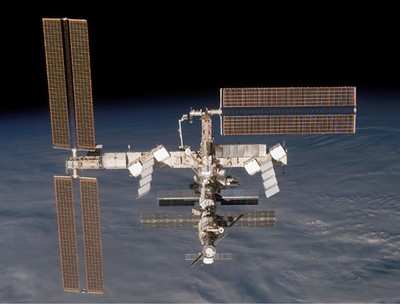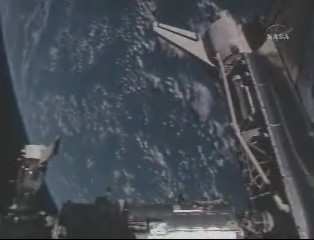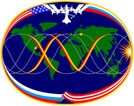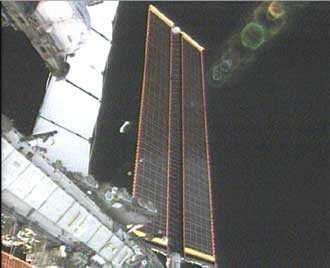Russia May Move Up Cargo Flight To Bring New Parts
The combined Expedition 15 and STS-117 crews spent a second day
Friday attempting to reboot problematic computer systems onboard
the International Space Station, as controllers on the ground
mulled over possible options -- including moving up a planned
resupply flight to bring up needed parts, or abandoning the
station.

The latter remains a remote possibility, though engineers must
solve a series of cascading computer failures before they can
guarantee the station will remain manned. Those failed computers,
which first experienced problems Wednesday, control the station's
orientation in orbit... and the station's Elektron
oxygen-generating system.
For the moment, the docked space shuttle Atlantis may use its
thrusters to help maintain the station's position, reports The
Associated Press. And the station has enough breathable air for 90
days, according to Russian space officials.
"We have enough time to calmly deal with the situation," said
Russian Mission Control chief Vladimir Solovyov. "There is no need
to rush."

NASA instructed astronauts Thursday to shut down non-critical
electronics onboard Atlantis -- including cameras, laptop computers
and lighting equipment -- to conserve energy, in case officials
determine the shuttle should remain docked to the station for
another day to help with the situation.
As ANN reported, NASA already
extended Atlantis' mission by two days earlier this week, to
provide time for an extra spacewalk to repair a thermal blanket
that pulled free from one of the shuttle's orbiting maneuvering
system pods during its June 8 launch.
If engineers and cosmonauts aren't able to repair the
Russian-made computers, the station's orbit could drop to as low as
200 miles above Earth -- roughly 37 miles lower than its current
orientation. Solovyov said this isn't an alarming amount -- but the higher the orbit, the less air there
is to create atmospheric drag to pull the station even
lower.
 For the moment, crews
onboard the ISS are split along national lines -- with Russian
cosmonauts working to solve the computer problems, and NASA
astronauts continuing to perform construction work and
spacewalks.
For the moment, crews
onboard the ISS are split along national lines -- with Russian
cosmonauts working to solve the computer problems, and NASA
astronauts continuing to perform construction work and
spacewalks.
"We've had computer failures before, and we have coped with the
problem, but now the situation is much more complicated," cosmonaut
Pavel Vinogradov told NTV television. "We have the shuttle docked
to the station, and active work is going on at the station -- the
Americans' space walk. We must maintain the station's
orientation."
During a third spacewalk, scheduled to begin Friday afternoon,
STS-117 Mission Specialists Jim Reilly and Danny Olivas will tackle
separate tasks when they begin the mission's third spacewalk.
Olivas will be tasked with repairing the thermal blanket on
Atlantis -- by first tucking it back into position, then stapling
it down on the left orbital maneuvering system pod.
Meanwhile, Reilly will install a hydrogen vent on the
International Space Station's Destiny Laboratory. The vent is for a
new oxygen generation system.
The duo will then go to the top of the station’s Port (P6)
truss to assist in the retraction of a solar array. Over a two-day
period the crew has folded most of the array bays. A future shuttle
crew will relocate the P6 to the end of the Port 5 truss.
Scientists are looking at the possibility earlier work on the
station may have led to the current computer problem. Nikolai
Sevastyanov, head of Russia's RKK Energiya, said the problem began
with a spike in static electricity while cables were being hooked
up between the station and the new solar arrays installed earlier
this week. That theory is supported by NASA engineers, as well.

"A power line has a certain magnetic field around it, and that
can affect systems near it," said Mike Suffredini, NASA's space
station program manager. "This is the leading theory."
 ANN's Daily Aero-Linx (04.30.25)
ANN's Daily Aero-Linx (04.30.25) ANN FAQ: Turn On Post Notifications
ANN FAQ: Turn On Post Notifications Classic Aero-TV: Agile Aeros Jeff Greason--Disruptive Aerospace Innovations
Classic Aero-TV: Agile Aeros Jeff Greason--Disruptive Aerospace Innovations Aero-News: Quote of the Day (04.30.25)
Aero-News: Quote of the Day (04.30.25) ANN's Daily Aero-Term (04.30.25): Expedite
ANN's Daily Aero-Term (04.30.25): Expedite






